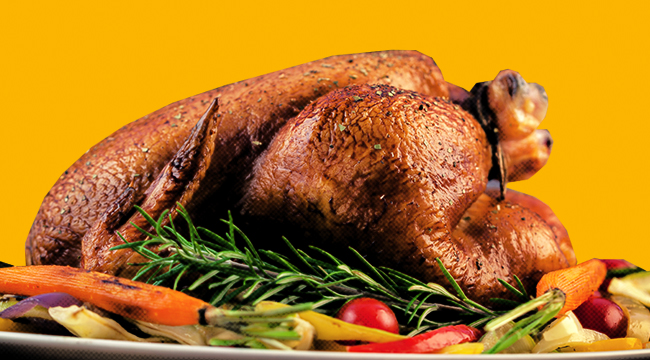
We eat a lot of turkey in America. Each of us eats around 16.5 pounds of turkey every year equating to over 5.5 billion pounds nationwide. The lion’s share of that turkey is eaten every day on turkey sandwiches and the rest is downed this week, during Thanksgiving when we eat close to two of those 16 pounds over the coming days. That’s a lot of turkey.
With the prime turkey buying season upon us, we figured it’s time to throw down some hard and fast rules for purchasing the center of Thursday’s big meal. Let’s face it, the best meals come from the best products. There are a few nuances here and there that make a huge difference even to the most basic recipes and having a great main ingredient is the biggest one. This isn’t about the overall, it’s about the details that are often overlooked and can make or break your meal.
Air-chilled, heritage bird, pre-brined, free range: These are the four phrases you want to be aware of. Let’s dive in.
Air-chilled
This means the bird wasn’t put into an ice water bath to cool it down as quickly as possible after slaughter. The USDA allows all poultry to contain 15 percent of that water as part of its weight to accommodate this process. You’re basically throwing 15 cents on the dollar away on bloody, chlorine infused slaughterhouse water when you don’t buy air-chilled poultry, and that’s just bad accounting.
There’s also a much higher chance of cross-contamination in those cooling baths that can lead to foodborne illnesses if the turkey isn’t handled correctly on your end in the kitchen. This is not a great situation.
Air-chilled means the bird never touches that water. Instead, the freshly slaughtered birds are run through a cooling room that does the same thing to the carcass without it ever getting bogged down with dirty water or touching any other turkey. It’s safer, cleaner, and doesn’t add chlorine water to your Thanksgiving turkey. Overall, air-chilled is the only way to go here.
Heritage Breeds
Heritage turkeys are the closest to wild turkeys in domestication. They’ll have a much richer tasting meat — the breast meat will be juicer and the thigh meat will be fattier. Both of these things are something you want in your Thanksgiving turkey.
Bourbon Red, Standard Bronze, Narragansett, Auburn, Buff, Black, Royal Palm, Slate, and Midget White are the breeds you’ll see. Sometimes the label will just say one of those breeds and assume you’ll know it means heritage.
If the label isn’t helping you with this information, ask your local butcher or grocery store meat manager. They’ll have this information and likely be happy to talk about what they’re selling.
Though it is worth noting that these birds are going to be mostly found at local butcher shops, higher-end grocery stores (think Whole Foods), and farmer’s markets. It’ll probably be worth looking up your local poultry farm today and seeing if they have any birds left to pick up tomorrow — still giving you plenty of time to start up that brine!
Pre-Brined Or Not Pre-Brined
If you’re buying a frozen turkey, it’ll likely be pre-brined. Granted, this isn’t always true — especially if you’re looking for a heritage breed from a farm. But, in most cases, this is likely the scenario you’ll find yourself in. It’s also worth noting that a lot of turkeys from the big suppliers come pre-brined even if they’re fresh. All of this is just more reason to buy fresh from a farmer.
Over at Butterball, their “All-Natural Fresh Turkey” is pre-brined in “a solution of water, salt, and spices to enhance tenderness and juiciness.” That’s pretty vague. Moreover, four percent of the turkey’s weight is that brine. So, in essence, you’re paying for some salty water with your turkey.
Brine is all about the nuance. You can add herbs and aromatics to amp up specific flavors that’ll make your turkey shine. This gives you control over the flavor of the turkey and the outcome. You can accommodate longer brining times that’ll enrich your turkey and keep in super moist. You want that.
Lastly, pre-brined turkeys fall into the same situation as birds that were chilled by water instead of air. A lot of turkeys are going into a bath and you don’t want that. Keep it out of ice baths for chilling and baths for brining. You do your turkey and that means taking the brining responsibilities into your hands.
Free Range
Free range is a no-brainer. Don’t eat meat that lived a shit life. It’ll taste blander, for one. Plus, you don’t want to eat an animal that suffered through the only days it had on this planet. It’s that simple. You vote with your pocketbook every time you go shopping. Vote for the ethical treatment of the protein you’re spending all that money on.
Free range will also likely be a heritage bird and, hopefully, air-chilled. So you’ll be able to hit all these points at the same time.
You can find these turkeys by going to farmers markets and/or farms in your area. Even if you’re in a city, it’s worth a short train ride or drive out of town to hit up a farm. Saving that, go to a higher end supermarket or ask behind the counter at your local supermarket. Sometimes grocery stores can do special orders for you. But today will be the last chance for something like that in 2017 — act fast.
From there, how you choose to cook your turkey is up to you. Fry it up, sous vide it, break it down and roast it at different temperatures for dark and white meats, or do it old school in the oven stuffed with plenty of dope stuffing. Lastly, here’s a great video from the Culinary Institute of America to help you carve a turkey. Good luck!
Oh, yeah, don’t forget the pie.






